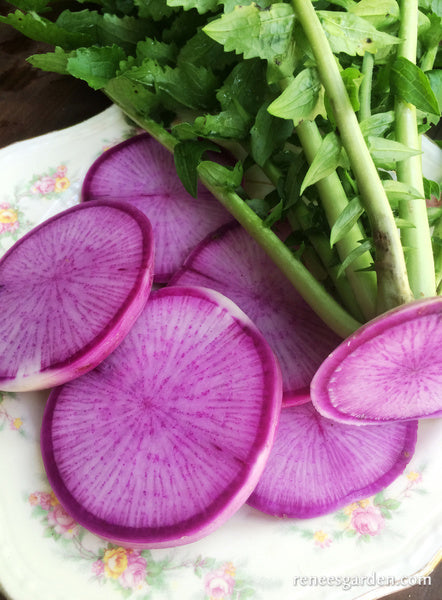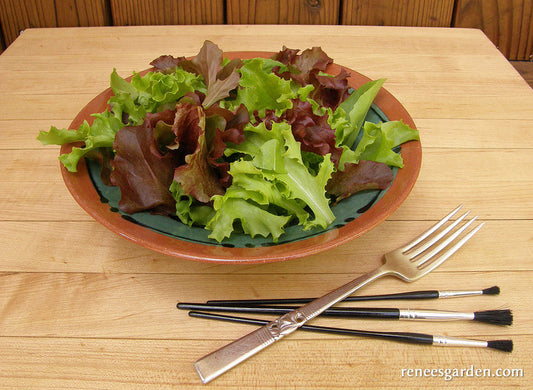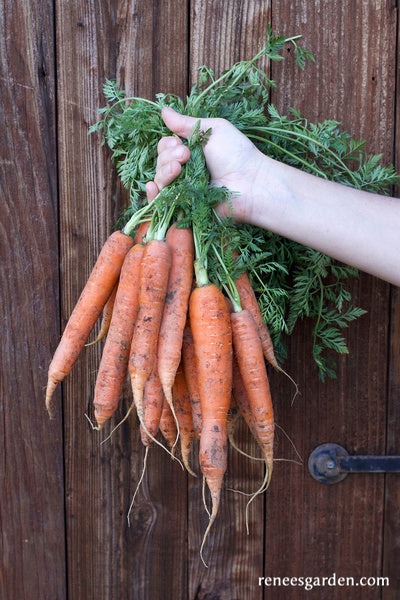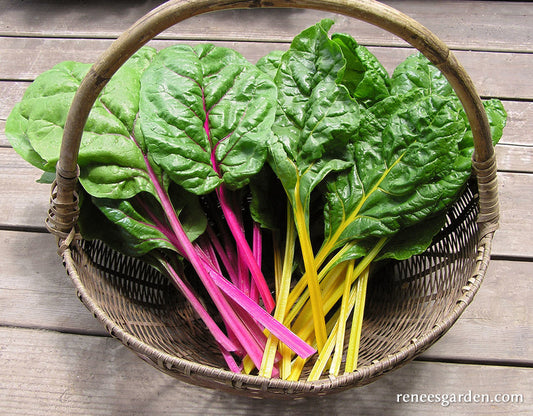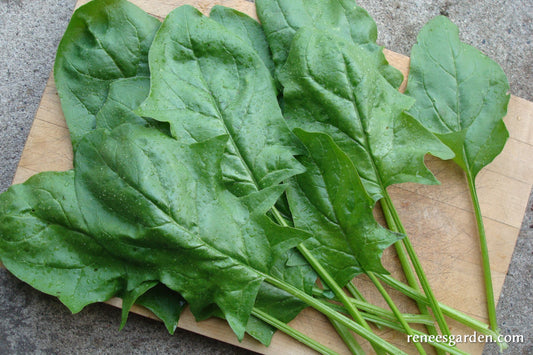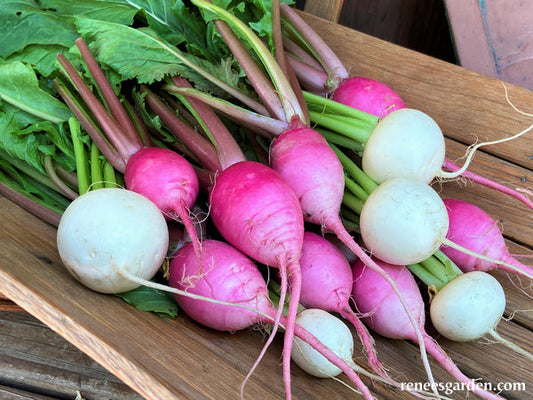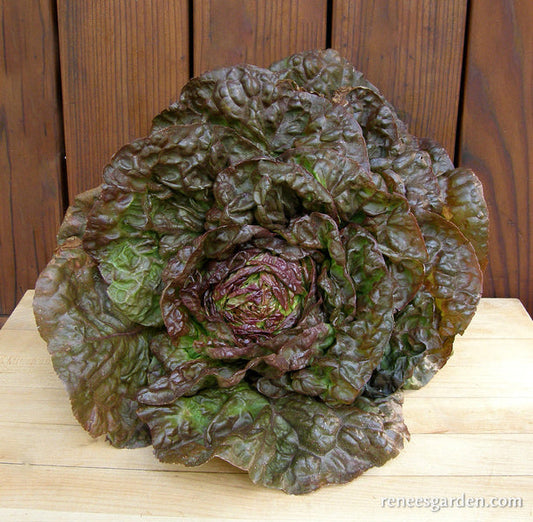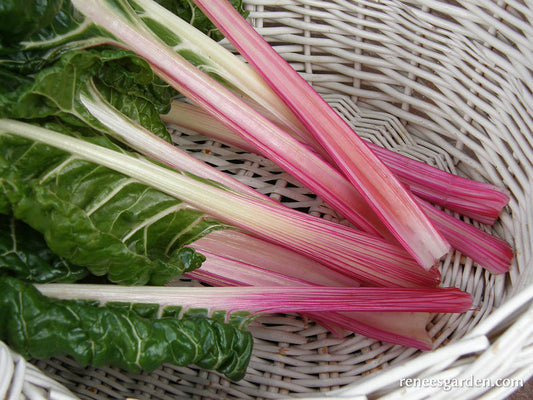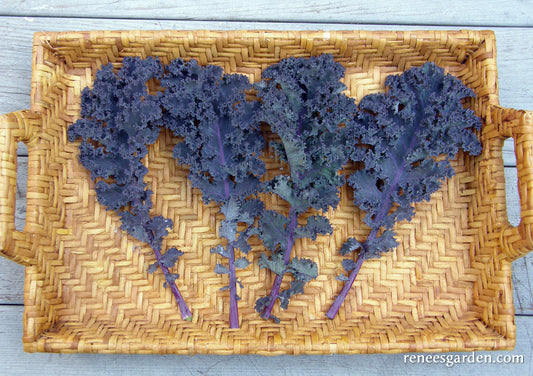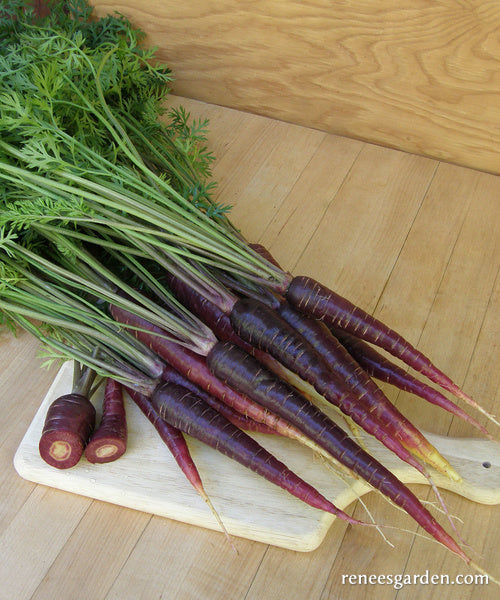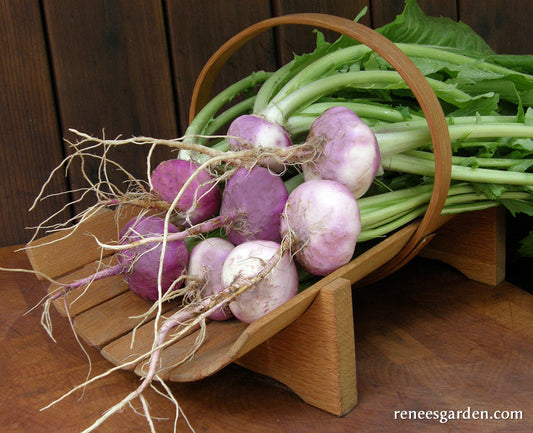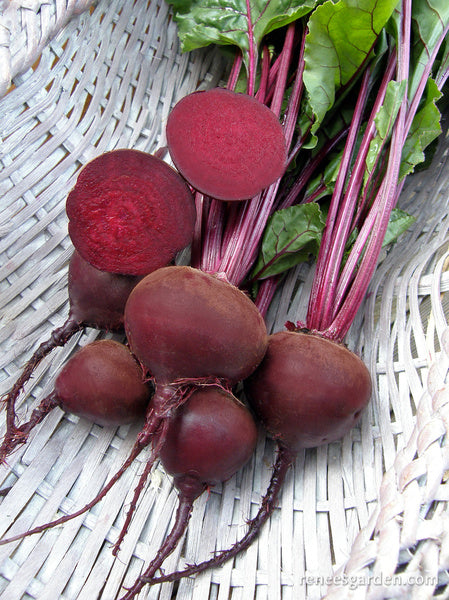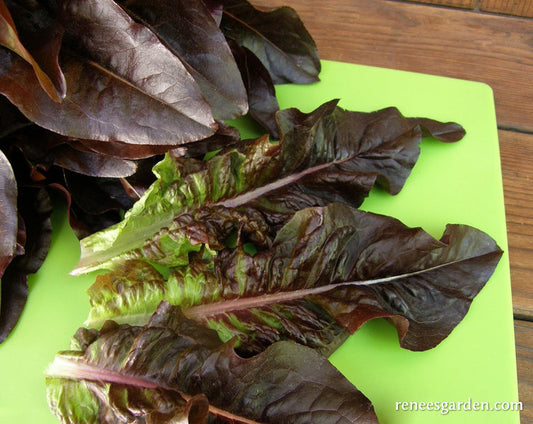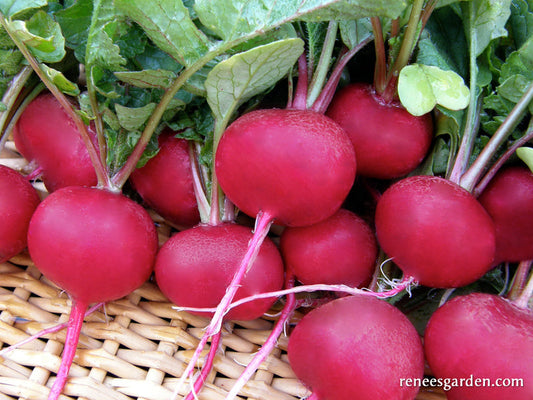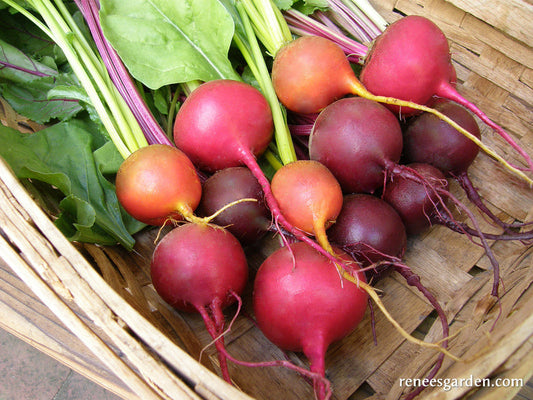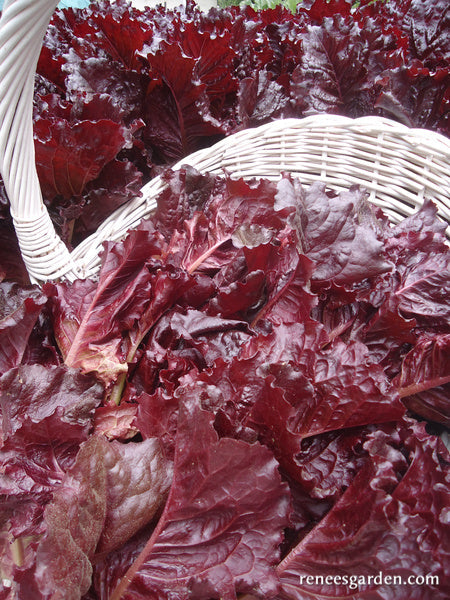Cool Weather Vegetables and Herbs
Easy to grow, highly nutritious and great tasting, these favorite early spring vegetables love cool weather and are the first varieties you can direct sow in the garden. If you live in colder climates, sow as soon as the danger of frost has passed. Fast-growing for earliest harvests, you'll find complete planting instructions on every packet and on our website.
-
Daikon Radish Mini Purple
START SEEDS OUTDOORS
In early spring as soon as ground can be worked, sow daikon radish seeds in a sunny spot with well-drained soil. Space seeds 2-3 inches apart in rows 6 inches apart. Cover 1/2 inch deep. Keep soil evenly moist and well weeded. If first sowing comes up unevenly, replant right away. Sow again in mid summer for a fall crop.
GROWING NOTES
For crispy flesh and mild flavor, give daikon radishes consistent moisture. When they are several inches tall, carefully thin seedlings to 3-4 inches apart, so the roots have room to size up and mature. Enjoy early thinnings in salads. Protect radishes with floating row covers if marauding birds or flea beetles that chew holes in the leaves are a problem.
HARVEST AND USE
If weather turns unexpectedly hot, pull, cut off tops and store the roots in the refrigerator where they keep very well. Daikon radish flavor is spicier in hot weather and milder in cool conditions. Slice and eat fresh, add to salads, shred for coleslaw or enjoy in stirfries, soups, and stews. Flavor is milder when cooked. Mini Purple daikon are delicious pickled in rice vinegar and will make a crunchy, colorful kimchee!
Regular price $4.69Sale price $4.69Unit price / per -
Signature Salads Monet's Garden Mesclun
START SEEDS OUTDOORS
In cool early spring weather, sow seeds in finely worked soil in full sun. Shake seeds from the palm of your hand, broadcasting them about a 1/2 -1 inch apart over the entire seedbed or in wide rows, and cover lightly and evenly with 1/4 inch of fine soil. Firm soil gently and water with a fine spray. Keep seedbed evenly moist. Make small successive sowings until summer weather turns hot for a constant supply. Plant again in late summer for fall harvesting.
GROWING NOTES
Mesclun lettuces thrive in mild weather with consistent moisture. To extend the sowing season into hot weather, sow in light shade or erect a canopy of loosely woven shade cloth over the mesclun bed. Birds are often attracted to tender young seedlings, so protect them if necessary.
HARVEST AND USE
To harvest by the “cut and come again” method, wait until plants are 4 or 5 inches tall. Cut as much lettuce as you need, using scissors to shear off a patch of leaves 1 to 2 inches above the soil level. Water well and fertilize lightly and plants will regrow for several more cuttings. Dress with a simple vinaigrette to enjoy the sweet flavor and juicy texture of these delicate young leaves at their best.
Regular price $2.99Sale price $2.99Unit price / per -
Top Flavor Carrots Napoli
START SEEDS OUTDOORS
In spring once danger of hard frost is past, sow seeds in full sun in finely worked, fertile soil. Sow 1/4 inch deep and 1/2 inch apart in rows 8 inches apart, or broadcast thinly in beds and cover lightly. Keep seedbed evenly moist as carrots can be slow to germinate, emerging over 10 to 20 days. If first sowing comes up unevenly, replant right away as seedlings catch up quickly. Be sure to thin young carrots several times so seedlings are about 2 inches apart and have room to size up.
GROWING NOTES
Carrots like well worked soil and need consistent moisture to grow well. If your soil tends to dry out, cover seedbed with floating row cover to help retain moisture during the germination period and water right through it. Keep carrots well watered and thinned. For a late season crop, sow again 3 months before first expected frost.
HARVEST AND USE
Let young carrots size up and color fully to orange before harvesting for best flavor. Saute or steam just until tender crisp and serve with a squeeze of fresh lemon or lime juice, sweet butter and fresh dill; or try buttered and glazed with a little maple syrup or honey.
Regular price $4.89Sale price $4.89Unit price / per -
Rainbow Chard Neon Glow
START SEEDS INDOORS
In early spring, when danger of frost is over, sow seeds in well-worked, fertile soil in full sun. Sow seeds 1/2 inch deep and 2 inches apart in rows 10 inches apart, or broadcast thinly for bed planting. Firm soil well over these irregularly shaped seeds to ensure good germination. If first sowing germinates unevenly, plant more seed as seedlings catch up quickly. When large enough to handle, thin seedlings to final spacing of 8 to 10 inches apart so these large plants have room to grow and mature. Transplant extras or enjoy young thinnings as early greens and salads.
GROWING NOTES
Chard grows well in a wide range of conditions and can take some light frost. In mild winter areas, it can be grown year round. Give seedlings enough room, because chard grows into large vase-shaped plants 2 feet tall.
HARVEST AND USE
Begin harvesting when plants are well established and have at least 6 to 8 leaves. Both stalks and leaves make great eating. Chop and steam or sauté with garlic and olive oil. Use like spinach in lasagna or minestrone soup. Try tasty chard leaves stuffed and poached in broth with a dash of olive oil and fresh lemon.
Regular price $3.39Sale price $3.39Unit price / per -
Japanese Spinach Oriental Giant
TO START OUTDOORS
In early spring when danger of hard frost is over, sow seeds in well-worked fertile soil in full sun. Space seeds 1 inch apart in rows 8 to 10 inches apart, or broadcast thinly for bed planting. Cover with 1/2 inch of soil; firm soil over seeds to ensure good germination. If first sowing germinates unevenly, plant more seeds as they will catch up fast.
GROWING NOTES
Spinach is most productive grown in cool spring conditions and sown again in late summer for a fall crop. After seedlings reach 2 to 3 inches tall, thin out every other plant (and enjoy in early salads) and keep thinning in this fashion until plants are spaced 8 or 10 inches apart. Keep the shallow-rooted plants well weeded and watered. Spinach is a heavy feeder so fertilize several times with a high nitrogen source like fish emulsion solution for best harvests.
HARVEST AND USE
Wait until plants are well established and harvest just the outer leaves, leaving at least 4 younger center leaves so plant will continue to grow. Water and fertilize after cutting and plants will provide 2 or 3 pickings before weather gets too warm and spinach begins to go to seed. Plant again in late summer to early fall for a succulent autumn crop.
Regular price $3.39Sale price $3.39Unit price / per -
Salad Scallions Parade
EASIEST TO START OUTDOORS
Plant scallions throughout the spring and again in mid to late summer for fall harvests. Sow seeds in well-worked, fertile soil in full sun. Space seeds 1 inch apart in rows 8 to 10 inches apart, or broadcast thinly for bed planting. Cover 1/4 inch deep and firm soil well over seeds. Be sure to keep soil evenly moist to ensure good germination.
THIN OR TRANSPLANT
Space 1 to 2 inches apart, allowing plants room to mature.
GROWING NOTES
Scallions take up little garden space, so tuck several rows around beds of lettuce, spinach or radishes. Make several plantings a month apart to have a constant supply for spring and summer meals. Prepare soil well with lots of aged manure or compost before planting. Keep evenly moist and weed carefully when plants are young. Mulching to conserve soil moisture and suppress weed growth is a good strategy.
HARVEST AND USE
To get the most out of your crop, start by using tender, mild-flavored early thinnings in salads, then continue thinning gradually so mature scallions stand an inch or two apart. These tasty scallions are best if harvested at 10 to 12 inches tall or before they send up bloom stalks, which makes the stems turn tough and too spicy.Regular price $3.99Sale price $3.99Unit price / per -
Lawn & Patio Parsley Italian Flat Leaf Seeds
(Petroselinum crispum)
Rich with flavor and definitely essential for any cook’s garden. Large, dark green, sweet leaves add delicious extra flavor to both cooked dishes and fresh salads.Regular price $2.29Sale price $2.29Unit price / per -
Baby Turnips Pastel Duo
START SEEDS OUTDOORS
In early spring, as soon as ground can be worked, sow in well worked, fertile soil in full sun. Sow this quick growing, cool season crop wherever you intend to plant heat lovers later. Space seeds 1 inch apart in wide rows 6 inches apart. Cover 1/2 inch deep. Keep soil evenly moist and well weeded.
GROWING NOTES
Thin seedlings early to stand 3 inches apart, giving them room to size up. Provide consistent moisture. Sow small amounts a week apart for successive harvests until summer heat comes on. Protect with floating row covers if marauding birds or flea beetles that chew holes in the leaves are a problem. Be sure to sow again in late summer for productive harvests in cool fall weather.
HARVEST AND USE
Harvest these sweet baby turnips from when they are as big as walnuts to when they are the size of ping-pong balls. If weather turns unexpectedly hot, pull and store the roots in the refrigerator. Turnips will be spicier in hot weather.
These pearly-white and pretty pink baby turnips are delicious sliced raw into green salads, or you can steam or sauté them briefly, or toss in oil and roast whole to bring out their natural sugars. Enjoy the tasty, nutritious green tops steamed or quickly braised.
Regular price $3.99Sale price $3.99Unit price / perNew -
Summer Bibb Lettuce Patty's Choice
START SEEDS OUTDOORS
In cool early spring weather, start seeds in finely worked soil in full sun. Sow 1/4 inch deep and 2 inches apart in rows 6 to 8 inches apart and cover lightly. Tend carefully and keep evenly moist. Gradually thin out extra seedlings, leaving remaining plants standing 12 inches apart so lettuces have room to size up and fully mature into big butterhead rosettes. For a constant supply, make several sowings a few weeks apart until summer weather turns hot. Plant again in late summer for fall harvest.
GROWING NOTES
Lettuce thrives in cool conditions with consistent moisture. Weed, water and be sure to thin carefully to proper spacing for best quality heavy heads. If birds are attracted to young seedlings, cover with floating row covers or netting. Make a shade structure in hotter climates to extend the growing season.
HARVEST AND USE
Savor young thinnings in your first spring salads. Then harvest plants by cutting mature heads when they feel firm and well-filled out. Be sure to thin properly and keep evenly moist for sweet tasting, full heads. Pull and discard or compost over-mature plants if they begin to elongate (“bolt”) in hot weather as leaves turn bitter at this stage.
Regular price $4.89Sale price $4.89Unit price / per -
Gourmet Chard Peppermint Stick
START SEEDS INDOORS
In early spring, when danger of frost is over, sow seeds in well-worked, fertile soil in full sun. Space seeds 1 inch apart and cover 1/2 inch deep in rows 10 inches apart, or broadcast thinly for bed planting. Firm soil well over these irregularly shaped seeds to ensure good germination. If first sowing germinates unevenly, plant more seed as the seedlings catch up quickly. When large enough to handle, thin seedlings to 8 to 10 inches apart so these large plants have room to grow and mature. Transplant extras or enjoy young thinnings as early greens and salads.
GROWING NOTES
Chard grows well in a wide range of conditions and can take some light frost. In mild winter areas, it can be grown year round. Give seedlings enough room, because chard grows into large vase-shaped plants 2 feet tall.
HARVEST AND USE
Begin harvesting when plants are well established and have at least 6 to 8 leaves. Both stalks and leaves make great eating. Chop and steam or sauté with garlic and olive oil. Use like spinach in lasagna or minestrone soup. Try tasty chard leaves stuffed and poached in broth with a dash of olive oil and fresh lemon.
Regular price $3.69Sale price $3.69Unit price / per -
French Breakfast Radishes Petit Dejeuner
START SEEDS OUTDOORS
In early spring as soon as ground can be worked, sow radish seeds in well-worked, fertile soil in full sun. Space seeds 1 inch apart in wide rows 6 inches apart. Keep soil evenly moist and well weeded. If first sowing comes up unevenly, replant right away. Sow in late summer for a fall crop.
GROWING NOTES
Sow this quick cool season crop wherever you intend to plant heat lovers later. Radishes thrive with crisp flesh and mild flavor when given consistent moisture. Sow small amounts a week apart to mature in warm but not hot weather. Thin quick-growing seedlings early to 2 inches apart so roots have room to size up. Protect radishes with floating row covers if marauding birds or flea beetles that chew holes in the leaves are a problem.
HARVEST AND USE
Pull young round roots at large marble size and cylindrical ones at 2 to 3 inches long. If weather turns hot, harvest, cut off tops and store in fridge. Radishes’ flavor is mildest in cool weather, spicier in hot conditions. Picked young and tender, these refined French treats make crispy snacks or attractive appetizers, and add appealing color and crunch to green salads. Especially delicious sliced and tossed with a sesame flavored dressing.Regular price $2.99Sale price $2.99Unit price / per -
Heirloom Radishes Pink Beauty
START SEEDS OUTDOORS
In early spring as soon as ground can be worked, sow radish seeds in well-worked, fertile soil in full sun. Space seeds 1 inch apart in rows 6 inches apart. Cover 1/2 inch deep. Keep soil evenly moist and well weeded. If first sowing comes up unevenly, replant right away. Sow again in late summer for a fall crop.
GROWING NOTES
Sow this quick growing, cool season crop wherever you intend to plant heat lovers later. Radishes thrive and have crisp flesh with the best mild flavor given consistent moisture. Sow small amounts a week apart to mature in warm but not hot weather. Thin quick-growing seedlings early to 2 inches apart so roots have room to size up. Protect radishes with floating row covers if marauding birds or flea beetles that chew holes in the leaves are a problem.
HARVEST AND USE
Harvest radishes when roots are the size of large marbles. If weather turns unexpectedly hot, pull, cut off tops, and store in the refrigerator for up to 3 weeks. Radishes will be spicier in hot weather and milder grown in cooler conditions. Combine sliced radishes, scallions and fresh dill or parsley for a great salad. Make delicious open faced sandwiches on whole grain bread spread with sweet butter and topped with sliced radishes.Regular price $4.89Sale price $4.89Unit price / per -
Container Chard Pot of Gold
EASIEST TO START OUTDOORS
For container sowing, use pots at least 12 inches in diameter and 12 inches deep and start with fresh potting mix. Plant seed in spring, after danger of frost is over, and/or again in mid-summer for fall harvests. Sow seed 1/2 inch deep and 1 inch apart in full sun. Keep evenly moist.
When seedlings are several inches tall, gradually thin to 8 inches apart in containers and use the delicious thinnings for early greens. Be sure to thin seedlings well so the large, vase-shaped plants have room to mature. If planting in garden beds, thin seedlings to stand 12 inches apart.
GROWING NOTES
Easy to grow chard can be grown year-round in mild winter areas. It prefers full sun, but will tolerate afternoon shade. Water regularly, checking containers daily in hot weather. Feed these fast-growing, productive plants weekly with a good high-nitrogen fertilizer. Watch for snails and slugs.
HARVEST AND USE
Begin harvesting when plants are well established and have 6 to 8 stalks. Both the crunchy succulent stalks and leaves make great eating. Break stems off at the base of the plant, always leaving at least 3 to 4 stalks to allow for regrowth. Chard is delicious sautéed, steamed, braised or stirfried. It pairs beautifully with the flavors of olive oil, garlic and lemon.
Regular price $3.39Sale price $3.39Unit price / per -
Gourmet Kale Purple Moon
TO START DIRECTLY IN THE GARDEN
As soon as ground can be worked in spring, plant in well-drained, fertile garden soil in full sun. Sow groups of 3 seeds each 10-12 inches apart and 1/2 inch deep, in rows 12-18 inches apart. Keep soil evenly moist. When seedlings are 3 inches tall, thin to just 1 seedling per group. Sow again in late summer.
TO START INDOORS
Sow seeds 2 in. apart and 1/2 in. deep in a container of seed starting mix. Keep moist and provide a strong light source until seedlings reach 3 to 4 in. tall, then plant outdoors 10 to 12 in. apart.
GROWING NOTES
Kale tastes best in cool weather, so sow spring crops early. A late summer-sown crop will yield through fall and winter except in the coldest climates. Frost actually enhances kale leaf color, flavor and sweetness. Mulch to retain moisture in summer and before the ground freezes to protect the roots of fall crops.
HARVEST AND USE
Begin harvesting outer leaves when plants have 6 to 8 leaves. Vitamin-rich kale is delicious with stems removed and leaves cut in very thin strips for fresh salads with nuts and fruit. Braise with garlic and olive oil in traditional Mediterranean style. Enjoy in hearty winter soups, stews and sautés. Pull and discard once plants begin to bloom as flowering plants get tough and bitter.
Regular price $4.89Sale price $4.89Unit price / per -
Rainbow Carrots Purple Sun
START SEEDS OUTDOORS
In spring once danger of hard frost is past, sow seeds in full sun in finely worked, fertile soil. Sow 1/4 inch deep and 1/2 inch apart in rows 8 inches apart, or broadcast thinly in beds and cover lightly.
Keep seedbed evenly moist as carrots can be slow to germinate, emerging over 10 to 20 days. If first sowing comes up unevenly, replant right away as seedlings catch up quickly. Be sure to thin young carrots several times so seedlings are about 2 inches apart and have the room they need to size up.
GROWING NOTES
Carrots like well-worked soil and need consistent moisture to grow well. If your soil tends to dry out, cover seedbed with floating row cover to help retain moisture during the germination period and water right through it. Keep carrots well watered and thinned. For a late season crop, sow again 3 months before first expected frost.
HARVEST AND USE
For best flavor, let Purple Sun carrots size up and color up fully before harvesting. Enjoy these beautiful, extra healthy carrots raw as snacks or grated into salads for great eye appeal. Sauté or steam just until tender crisp and serve with a little sweet butter and your favorite fresh chopped herb. Carrots go well with dill, tarragon, chives, cilantro or mint.
Regular price $4.69Sale price $4.69Unit price / per -
Heirloom Turnip Purple Top Milan
START SEEDS OUTDOORS
In early spring, as soon as ground can be worked, sow in well worked, fertile soil in full sun. Space seeds 1-2 inches apart in wide rows 6 inches apart. Cover 1/2 inch deep. Keep soil evenly moist and well weeded. Carefully thin seedlings early to stand 4-6 inches apart, giving them room to size up. Provide consistent moisture.
GROWING NOTES
Make a second spring sowing 10 days later, before summer heat. Protect with floating row covers if marauding birds or flea beetles that chew holes in the leaves are a problem. Sow again mid to late summer for fall harvest.
HARVEST AND USE
Begin harvesting when the turnips reach 2 to 3 inches in diameter. If weather turns unexpectedly hot, pull and store the roots in the refrigerator.
Note: Turnips are always spicier when the weather turns hot. Slice and sauté or steam; use in soups and stews, or (and this is our favorite) just cut them in quarters or large chunks, toss with olive oil, then roast in the oven until tender to bring out their natural sugars. Enjoy the tasty, nutritious green tops steamed or quickly braised.
Regular price $4.89Sale price $4.89Unit price / per -
Crisphead Lettuce Queen of Crunch
START SEEDS OUTDOORS
In cool early spring weather, start seeds in finely worked soil in full sun. Sow 1/4 inch deep and 2 inches apart in rows 6 to 8 inches apart and cover seeds lightly. Tend carefully and keep evenly moist. Gradually thin out extra seedlings, leaving remaining plants standing 12 inches apart so lettuces have room to size up and fully mature into tight, crunchy rosettes. For a constant supply, make several sowings a few weeks apart until summer weather turns hot. Plant again in late summer for fall harvest.
GROWING NOTES
Lettuce thrives in cool conditions with consistent moisture. Weed, water and thin carefully to proper spacing for best quality heavy heads. If birds are attracted to the young seedlings, cover planting beds with floating row covers or netting. Make a shade structure in hotter climates to extend the growing season.
HARVEST AND USE
Savor young thinnings in your first spring salads. Be sure to thin properly and keep evenly moist for sweet tasting leaves. Harvest by cutting mature heads when they are well filled out. Pull and discard or compost over-mature plants if they begin to elongate (“bolt”) in hot weather as leaves turn bitter at this stage.
Regular price $4.39Sale price $4.39Unit price / per -
Heirloom Greens Quick Stirfry Blend
BEST TO START DIRECTLY OUTDOORS
In cool early spring weather, sow seeds in finely worked soil in full sun. Shake seeds from the palm of your hand, broadcasting them about a half inch apart over the entire seedbed or in wide rows, and cover lightly and evenly with 1/4 inch of fine soil. Firm soil gently and water in with a fine spray. Keep seedbed evenly moist. Make small successive sowings until summer weather turns really hot for a constant supply. Plant again in late summer for fall harvesting.
GROWING NOTES
Our crunchy stir-fry mix tastes best given consistent moisture and mild weather conditions. Marauding birds are often attracted to tender young seedlings, so protect them if necessary with netting or floating row covers. Sown in a big container, these mixed leafy greens will make an ornamental and edible “color bowl” to snip and stir-fry as needed.
HARVEST AND USE
To harvest by the “cut and come again” method, wait until plants are 6 to 7 inches tall. Cut as much as you need, using scissors to shear off a patch of leaves 1 to 2 inches above the soil level. Water well and fertilize lightly and plants will regrow for several more cuttings. Sizzle these crunchy, succulent Asian greens in a quick stir-fry, or pick them earlier at 3 to 4 inches for tender young additions to colorful salads.
Regular price $4.89Sale price $4.89Unit price / per -
Dutch Beets Red Baron
START SEEDS DIRECTLY OUTDOORS
In early spring, when danger of hard frost is over, sow seeds in well-worked, fertile soil in full sun. Space seeds 1 inch apart in rows 8 to 10 inches apart, or broadcast thinly for bed planting. Firming soil well over these irregularly shaped seeds will ensure best germination. If first sowing comes up unevenly, sow more seeds as seedlings will catch up fast. When large enough to handle, carefully thin seedlings to 3 to 4 inches apart so growing beets have room to size up.
GROWING NOTES
For best quality, tender roots, sow seeds before midsummer heat and again in late summer to early fall — in cold climates, allow at least 10 weeks before fall frosts. Keep soil evenly moist throughout the season. Be sure to thin seedlings several times when plants are small, as beets grow best if given enough room.
HARVEST AND USE
These vigorous hybrids are fast growing. After thinning seedlings, use tender young tops for nutritious, flavorful steamed greens. Harvest baby beets at 1 to 2 inches in diameter, or let roots grow as large as desired. Garden fresh beets cook quickly. They are delicious steamed, boiled or baked whole in their skins like potatoes, then peeled for wonderful color and sweet concentrated flavor.
Regular price $4.89Sale price $4.89Unit price / per -
Heirloom Cutting Lettuce Red Deer Tongue
START SEEDS OUTDOORS
In cool early spring weather, sow seeds in finely worked soil in full sun. Sow seeds about 1 inch apart over the entire seedbed or in wide rows, then cover lightly and evenly with 1/4 inch of fine soil. Firm soil gently and water with a fine spray. Keep seedbed evenly moist. Plant again as weather cools in late summer for fall salads.
GROWING NOTES
Thin seedlings to stand about 6 inches apart so they have room to grow and mature. Heirloom Red Deer Tongue grows and tastes best grown in mild spring or cooler fall weather with consistent moisture. To extend the sowing season slightly, sow in light shade or erect a canopy of loosely woven shade cloth over the bed. Birds are often attracted to tender young seedlings, so protect them with netting if necessary.
HARVEST AND USE
To harvest, wait until the plants form open, loose heads with leaves about 6 inches tall. Use scissors to cut leaves about 1 to 2 inches above the soil level. Water well and fertilize lightly and if weather is still cool, plants will re-grow tasty leaves for another cutting. These tasty, deep red leaves show off in the salad bowl and add interest to any sandwich. Hot summer temperatures turn this heirloom lettuce bitter; plant and harvest in cooler weather.
Regular price $3.39Sale price $3.39Unit price / per -
Radishes Red Planet
START SEEDS OUTDOORS
In early spring as soon as ground can be worked, sow radish seeds in well-worked, fertile soil in full sun. Space seeds 1 inch apart in wide rows 6 inches apart. Cover 1/2 inch deep. Keep soil evenly moist and well weeded. If first sowing comes up unevenly, replant right away. Sow again in late summer for a fall crop.
GROWING NOTES
Sow this quick growing, cool season crop wherever you intend to plant heat lovers later. Radishes thrive and have crisp flesh and the best mild flavor given consistent moisture. Sow small amounts a week apart to ensure a constant supply. Thin quick-growing seedlings early to 2 inches apart so roots have room to size up. Protect radishes with floating row covers if marauding birds or flea beetles that chew holes in the leaves are a problem.
HARVEST AND USE
Harvest radishes when roots are the size of large marbles. If weather turns unexpectedly hot, pull, cut off tops, and store in the refrigerator for up to 3 weeks. Radishes will be spicier in hot weather and milder grown in cooler conditions. Combine sliced radishes, scallions and fresh dill or parsley for a great salad. Make delicious open faced sandwiches on whole grain bread spread with sweet butter and topped with sliced radishes.
Regular price $4.89Sale price $4.89Unit price / per -
Jewel-Toned Beets Red, Gold & Candystripe
START SEEDS OUTDOORS
In early spring when danger of hard frost is over, sow seeds in well-worked, fertile soil in full sun. Sow seeds 1 inch deep and 1 inch apart in rows 10 inches apart, or broadcast thinly and evenly for bed planting. Firm soil well over these irregularly shaped seeds to ensure good germination. If first sowing germinates unevenly, replant more seed in the rows as seedlings will catch up fast. Carefully thin when seedlings are large enough to handle to stand 3 to 4 inches apart so roots have room to grow and mature.
GROWING NOTES
For best quality tender roots, sow seeds before midsummer heat and again in early fall at least 10 weeks before fall frosts. Keep soil evenly moist throughout the growing season. Be sure to thin beet seedlings carefully several times when plants are small as they’ll grow best if given enough room.
HARVEST AND USE
After thinning seedlings, use tender young tops for nutritious flavorful steamed greens. Harvest baby beets at 1 to 2 inches in diameter, or let roots grow as large as desired. Garden fresh beets cook quickly. They are delicious steamed, boiled or baked whole in their skins like potatoes, then peeled for wonderful color and sweet concentrated flavor.
Regular price $3.69Sale price $3.69Unit price / per -
French Red Leaf Lettuce Redina
START SEEDS OUTDOORS
In cool early spring weather, start seeds in finely worked soil in full sun. Sow 1/4 inch deep and 2 inches apart in rows 6 to 8 inches apart and cover lightly. Tend carefully and keep evenly moist. Gradually thin out extra seedlings, leaving remaining plants standing 12 inches apart so lettuces have room to size up and fully mature into big butterhead rosettes. For a constant supply, make several sowings a few weeks apart until summer weather turns hot. Plant again in late summer for fall harvest.
GROWING NOTES
Lettuce thrives in cool conditions with consistent moisture. Weed, water and be sure to thin carefully to proper spacing for best quality heavy heads. If birds are attracted to young seedlings, cover with floating row covers or netting. Make a shade structure in hotter climates to extend the growing season.
HARVEST AND USE
Savor young thinnings in your first spring salads. Then harvest outside leaves as needed, or let plants mature and cut well-filled out heads. Be sure to thin properly and keep evenly moist for sweet tasting, full heads. Pull and discard or compost over-mature plants if they begin to elongate (“bolt”) in hot weather as leaves turn bitter at this stage.
Regular price $4.89Sale price $4.89Unit price / per -
Baby Salad Spinach Regiment
TO START OUTDOORS
In early spring when danger of hard frost is over, sow seeds in well-worked fertile soil in full sun. Space seeds 1 inch apart in rows 8 to 10 inches apart, or broadcast thinly for bed planting. Be sure to firm soil well over seeds to ensure good germination. If first sowing germinates unevenly, plant more seeds as they will catch up fast.
GROWING NOTES
Spinach is most productive grown in cool spring conditions and sown again in late summer for a fall crop. After seedlings reach 2 to 3 inches tall, thin out every other plant (and enjoy in early salads) and keep thinning in this fashion until plants are spaced 5 or 6 inches apart. Keep the shallow rooted plants well weeded and watered. Spinach is a heavy feeder so fertilize several times with fish emulsion solution for best harvests.
HARVEST AND USE
There are two methods for harvesting spinach: either cut the entire plant 1 inch or so above the base once plants are 4 or 5 inches tall, or wait until plants are well established and harvest just the outer leaves, leaving at least 4 center leaves so plant will continue to grow. Water and fertilize after cutting and plants will provide 2 or 3 pickings before weather gets too warm and spinach begins to go to seed.Regular price $4.89Sale price $4.89Unit price / per

